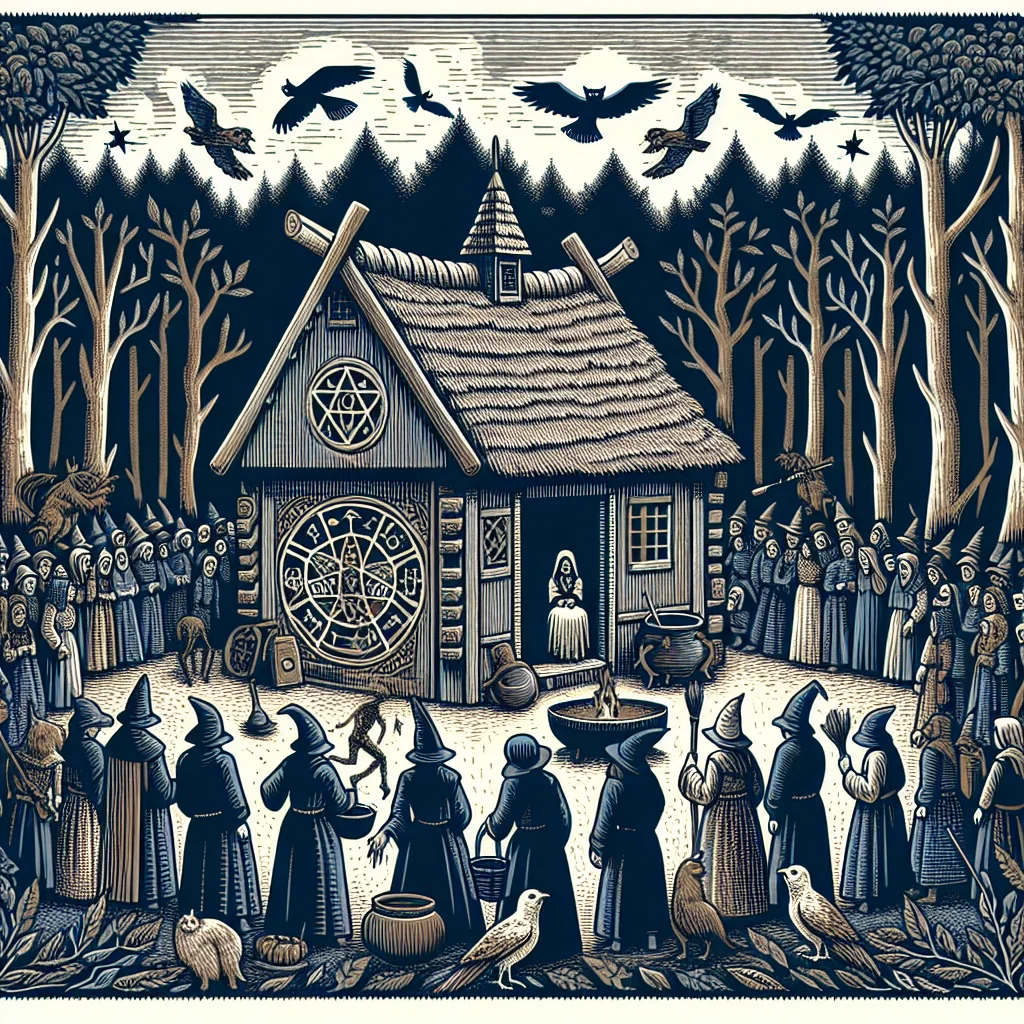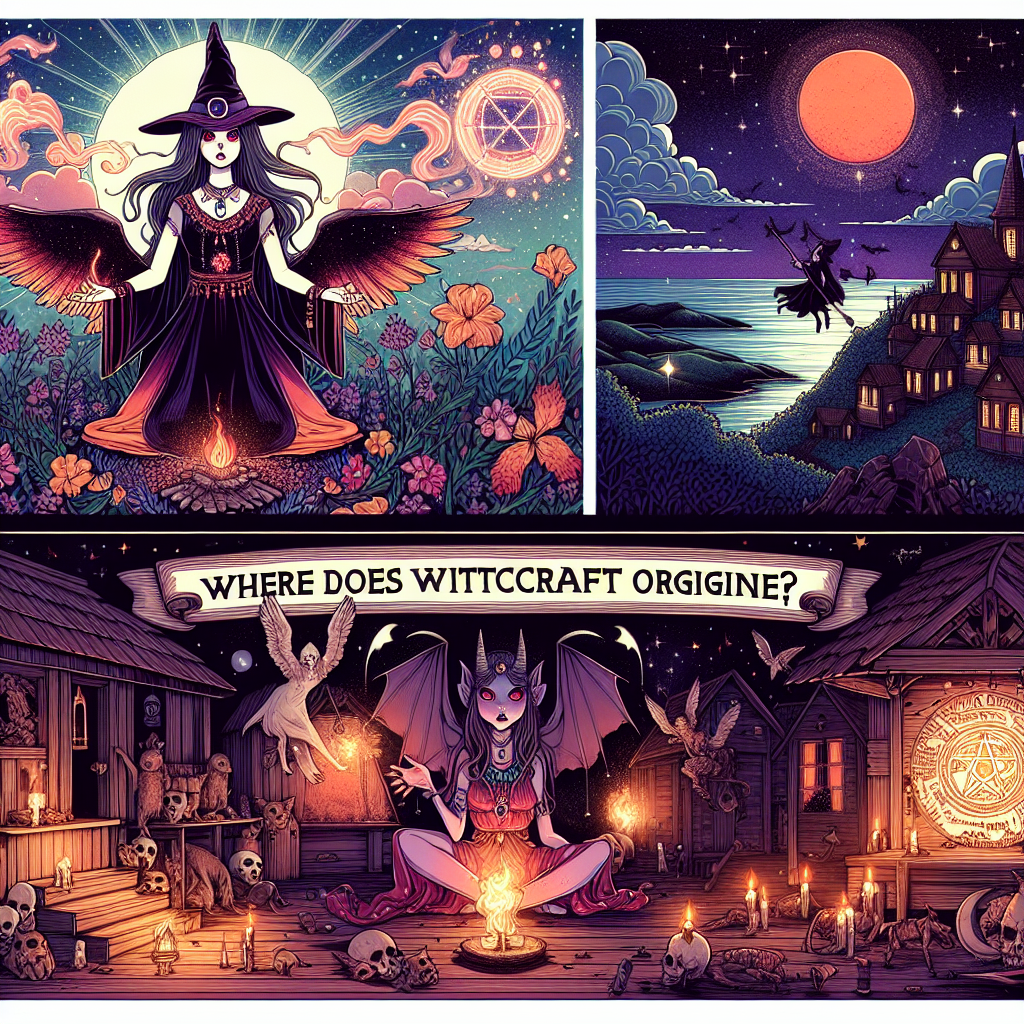As an Amazon Associate I earn from qualifying purchases.
Witchcraft, traditionally practiced across various cultures and societies, has been both feared and revered throughout history, and its existence has been recorded as early as the Paleolithic period. The concept of witchcraft has evolved, representing a complex interplay of spirituality, healing practices, and at times, malevolent magic. Historians and anthropologist suggest that the earliest forms of witchraft were closely tied to the shamanistic beliefs and customs of tribal communities, engaging with the spirit world for the benefit of the tribe.
Tracing the roots of witchcraft reveals a tapestry woven with threads from every part of the world. Ancient Mesopotamian tablets, for example, speak of witches who could “tie the wind” with spells, and the ancient Egyptians had their own magicians who used “heka” for both protective and destructive purposes. Across the ocean, indigenous cultures of Africa, the Americas, and Oceania held their own witchcraft traditions integral to their spiritual and cultural perspective.
In Europe, the perception of witchcraft took a dark turn during the medieval period, culminating in the infamous witch hunts that peaked between the 15th and 18th centuries. The Malleus Maleficarum, a notorious witch-hunting manual published in 1487, played a significant role in spreading the belief that witchcraft was heresy against Christianity. Consequently, tens of thousands of accused witches, predominantly women, were executed, marking a chilling period of history where fear overpowered reason.
Despite its tumultuous history, witchcraft has seen a resurgence in contemporary society, often associated with the rising interest in nature-based spirituality, paganism, and Wicca. The practice of modern witchcraft, sometimes referred to as “the Craft,” is now often associated with self-exploration, empowerment, and environmental awareness, distancing itself from the sinister stereotypes of its past. This is underscored by a compelling statistic: the Pew Research Center found that in 2014, 0.4% of Americans, or about 1 to 1.5 million people, identified as Wicca or Pagan, which suggests an increasing acceptance and redefinition of witchcraft in modern culture.
The intricate history of witchcraft reflects the complexities of human belief systems and the profound role that spirituality and the supernatural have played across different epochs and civilizations. The modern interpretation and embrace of witchcraft practices, despite the grim chapters of history, signify a robust continuity and transformation that underscores the influence of cultural and spiritual heritage on human society.
“`html
Exploring the Origins of Witchcraft: A Historical Insight
“`
Witchcraft, a practice often shrouded in mystery and errant myths, finds its origins sprawled across various ancient cultures. At its core, witchcraft can be defined as a set of beliefs and rituals considered to possess magical or supernatural powers, typically involving the invocation of spirits or the use of charms and spells. This multifaceted phenomenon has been known to play a part in religious, social, and cultural contexts, with historical traces dating back to prehistoric times and early shamanic traditions. Over the centuries, its manifestation has been recorded in the annals of history from the ancient civilizations of Egypt and Mesopotamia to the medieval witch hunts of Europe. This reflexive inquiry into the inception of these arcane practices nudges us to peel back the layers of time, inviting readers to delve deeper into the riveting narrative of witchcraft's diverse lineage in the following discussion.
Witchcraft, as a concept and practice, has deep roots reaching back into early human civilization. The origins of witchcraft are complex and multifacored, and while it is a challenge to pinpoint a single source, evidence suggests that forms of witchcraft, or magic rituals, arose independently across various cultures worldwide.
**Ancient Beginnings of Witchcraft**
The very roots of witchcraft are tied to prehistoric times when early humans practiced forms of magic and shamanism. Cave paintings, such as those found in the Lascaux Caves in France, suggest that rituals — possibly involving magical practices — were part of human culture over 17,000 years ago.
Moving into the ancient civilizations of Mesopotamia, ‘incantation priests' or āšipū might be considered early practitioners of what could be likened to witchcraft. They used rituals, spells, and amulets to ward off evil spirits or to bring good fortune. The ancient Egyptians similarly employed a type of magic — ‘Heka’ — which was performed by priests and laypersons alike.
**Witchcraft in Antiquity**
In classical antiquity, both the Greeks and Romans had their versions of witchcraft. The ancient Greek magical papyri from the 2nd century BC to the 5th century AD catalogue a range of spells and charms used for various purposes. Meanwhile, the Romans had strixae and veneficae, women often associated with flying and using ointments, who could be translated as witches.
**Medieval Period and Witch Hunts**
The perception of witchcraft dramatically shifted with the advent of Christianity in Europe. Early Christians often equated pagan practices with the work of the devil, leading to widespread condemnation of traditional magical practices. By the medieval era, the fear of witches intensified, reaching a peak with the European witch craze that lasted from the 15th to the 18th centuries. The Malleus Maleficarum, a notorious witch-hunting manual published in 1487, played a significant role in the persecution and execution of alleged witches.
**African and New World Influences**
The practice of witchcraft is also deeply rooted in African traditions, where it takes diverse forms across various cultures and often holds a mysterious power in both physical and spiritual worlds. When the transatlantic slave trade forced Africans to the Americas, they brought their spiritual beliefs with them, which interacted and amalgamated with indigenous American and European practices. This synergy gave rise to new traditions such as voodoo in Haiti, Obeah in Jamaica, and Santeria in Cuba, which have all been branded at times under the umbrella of witchcraft.
**Contemporary Witchcraft**
Modern witchcraft traditions, such as Wicca, first popularized in the mid-20th century by Gerald Gardner, draw on ancient pagan traditions mixed with ceremonial magic and folk practices. Gardnerian Wicca claims to be a direct continuation of the witchcraft of the Middle Ages, although historians typically see it as a new religious movement.
**Global Persistence of Witchcraft Beliefs**
Witchcraft persists as a subject of belief and practice globally, with variations varying widely by culture and society. In some contemporary societies, especially in parts of Africa and Asia, witchcraft accusations still lead to violence and persecution. At the other end of the spectrum, in western societies, witchcraft and pagan practices are increasingly embraced as part of diverse spiritual expressions.
Despite the difficult task of tracing witchcraft to a single point of origin, a 2014 Pew Research Center report concluded that belief in witchcraft is widespread, with as many of 95% of people in certain regions of sub-Saharan Africa believing in witchcraft, indicating the enduring presence and evolving nature of witchcraft practices and beliefs around the world.
- What is the definition of witchcraft?
Witchcraft generally refers to the practice of, and belief in, magical skills and abilities that are able to be exercised by individuals and certain social groups. It is broad in scope and varies culturally across the world.
- Where is the earliest known origin of witchcraft practices?
The earliest known witchcraft practices can be traced back to prehistoric times, with evidence found in cave paintings and artifacts suggesting that early humans believed in some form of magical rituals or sorcery.
- How did ancient civilizations perceive witchcraft?
Ancient civilizations often viewed witchcraft as an integral part of their spiritual systems, sometimes respected and revered, other times feared and persecuted, depending on the cultural norms and the role of magic in their society.
- What role did witchcraft play in ancient religions?
In ancient religions, witchcraft was often closely tied to religious practices, acting as a means to communicate with deities, spirits, or the deceased, to foretell the future, or to influence events through supernatural methods.
- How did the perception of witchcraft change during the Middle Ages in Europe?
During the Middle Ages in Europe, witchcraft became increasingly associated with heresy and devil-worship. This led to the persecution and execution of many individuals, especially women, who were accused of practicing witchcraft.
- What is the significance of the witch trials, such as those in Salem?
The witch trials, including those in Salem, are significant as they showcase the mass hysteria and social panic that can arise from fears of witchcraft, and also highlight the dangerous consequences of such unfounded fears and accusations.
- Can witchcraft be found in all cultures around the world?
Yes, various forms of witchcraft or magical practices can be found in cultures all around the world, each with its own set of beliefs, rituals, and traditions that reflect the diverse spiritual and religious landscapes of human societies.
- What role does witchcraft play in modern societies?
In modern societies, witchcraft often exists as part of neo-pagan practices, such as Wicca, or in the form of folk traditions and spirituality. It can be a source of personal empowerment, cultural identity, and alternative spirituality for practitioners.
- Is witchcraft always associated with evil or malevolent forces?
No, witchcraft is not always associated with evil or malevolent forces. In many cultures and modern practices, it is viewed as a neutral or even positive force that can be used for beneficial purposes such as healing, protection, and personal growth.
- What sources can be used to research the historical origins of witchcraft?
To research the historical origins of witchcraft, primary sources like historical texts, court records of witch trials, ancient artifacts, and contemporary accounts can be valuable. Additionally, scholarly research and analysis provide insights into the cultural and social factors that have shaped the history of witchcraft.

Conclusion
Tracing the origins of witchcraft reveals a complex tapestry woven from various cultural, religious, and societal strands that span across history and geography. From the ancient practices of the wise women and herbal healers of prehistoric times to the shamanic traditions of indigenous cultures, witchcraft has always been deeply rooted in an intimate connection with nature and the spiritual world. As we have discovered, iterations of witchcraft can be found in the magical rites of ancient Egypt and Babylonia, further evolving through the classical period of Greece and Rome, and into the medieval era, where it became entangled with Christianity and the politics of the time. This evolution reflects a history fraught with misunderstanding and persecution, culminating in the infamous witch trials that swept across Europe and the American colonies.
The insightful journey through the roots of witchcraft not only informs us about the practices themselves but also sheds light on the human psyche and societal constructs. It is evident that witchcraft has been both a means of empowerment and an emblem of the Other, resulting in a legacy that is as much about the resilience and adaptability of its practitioners as it is about the fears and prejudices of the societies that sought to suppress it. Whether viewed through the lens of anthropology, history, or spirituality, the origins of witchcraft serve as a mirror reflecting the complex interplay between human beings and their interpretation of the unknown. In essence, the genesis of witchcraft lies at the very heart of our quest to understand and harness the forces that shape our world.
Amazon and the Amazon logo are trademarks of Amazon.com, Inc, or its affiliates.


